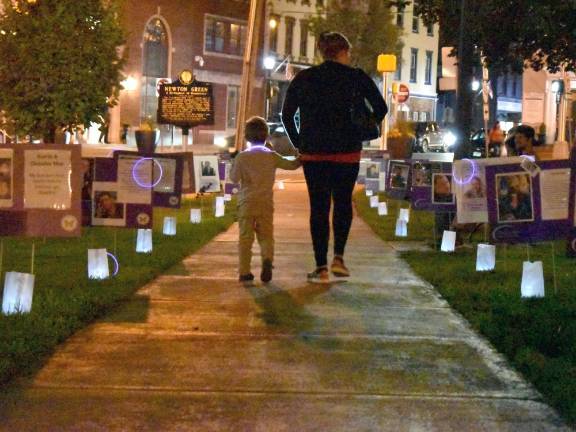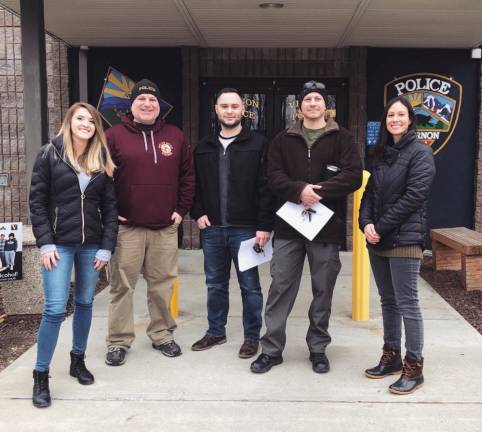As fentanyl continues to cut its deadly swath through American communities, a declining number of deaths by overdose represents a “glimmer of hope there in this otherwise tragic epidemic,” according to a captain with the New Jersey State Police.
The state had 7.4 percent fewer suspected fatal overdoses in 2022 than the previous year, according to data from state Attorney General Matthew Platkin’s office.
The 2,893 overdose fatalities last year were the fewest that the state has seen since 2017, according to data from the chief state medical examiner’s office.
“We have a long way to go, and, you know, one overdose is too many certainly, but we are trending down,” Capt. Jason Piotrowski of the State Police’s Office of Drug Monitoring & Analysis said during a December webinar hosted by Partnership for a Drug-Free New Jersey.
Drug-related deaths are on the rise among Black people and people age 55 and older, he said.
“It’d be great to see the tide turn, and I hope that’s what this is and the numbers start coming down,” said Becky Carlson, executive director of the Center for Prevention & Counseling in Newton. “We’ll see. It’s a little early to be able to tell.”
The dip in fatal overdoses – while encouraging – does not mean that drug use is letting up, say those on the front lines.
“We’d love to see that,” said Annmarie Shafer, director of recovery support services at the Center for Prevention & Counseling.
But based on the demand for the center’s services, people appear to be self-medicating as much as ever, she said. “We’re in an addiction epidemic – alcohol is probably leading that addiction epidemic, but people are medicating themselves and stress is a big factor,.”
“I think awareness about it is increasing – helping people understand, there’s services, there’s help, and you’re not going to get in trouble if you bring that to the forefront, and you’re not going to be stigmatized,” she added.
That sea change in awareness has come with robust government funding for an all-hands-on-deck approach, including “upstream” education in schools, one-on-one recovery coaching, law enforcement training and, critically, harm-reduction strategies, such as the wide distribution of naloxone, the overdose-reversal medication, and fentanyl strips, a newly legal drug-testing tool.
In 2022, Passaic County’s death toll was down 8 percent to 12 deaths a month, according to data from the chief state medical examiner’s office.
The complete picture of 2022 is not yet available nationwide. But the most recent data from the federal Centers for Disease Control and Prevention, updated Jan. 1, show that as of this summer, the downtrend was happening nationwide.
The most prominent decrease was on the top line: deaths related to synthetic opioids.
There is a lesson in caution to be taken from 2018. That year saw a 4 percent drop in overdose deaths, along with much back-patting and celebration – before we headed into the teeth of the opioid epidemic.
Overdose antidote
The single biggest lifesaver in the short term is widely agreed to be the ready availability of naloxone, commonly called Narcan.
“If we didn’t have Narcan, those numbers would be a lot, a lot higher,” said Katie Walker, a recovery specialist at the Center for Prevention & Counseling.
Available as a nasal spray, the overdose antidote blocks the effects of opiates in the brain and restores normal breathing.
It’s for sale at pharmacies for about $75 per two-dose box with a prescription, but it is often handed out free.
“Even in my car, I have a kit,” said Azmatullah Hussaini, medical director at Restorative Management Corps in Middletown, N.Y., who works on the outpatient end of addiction medicine. “Teaching about Narcan and how it’s administered and having all employees carry kits, in and out of the workplace, and giving these kits to any of our patients and having it readily available to them, their friends and family members – these are lifesaving measures.”
The number of naloxone administrations by law enforcement and emergency medical services in New Jersey was on pace to be up more than 7 percent in 2022 as of late November, according to data from the state attorney general’s office.
“It’s not necessarily a great barometer,” warned Piotrowski of the State Police. “It used to be, but now that there’s so much publicly available naloxone, we don’t have as good a handle on it as we used to when it was primarily used by first-responders.”
Naloxone was administered more than five times for every one fatal overdose in 2022, according to an opioid dashboard maintained by the Attorney General’s office.
“That could have been another 15,000 people that died, if they weren’t reversed from their overdose,” said Walker, the recovery specialist at the Center for Prevention & Counseling.
Still, the antidote is not a silver bullet, she said. “Narcan only works on opioids, and most drug overdose deaths involve other substances, too.”
Naloxone is now a stock item in school nurses’ offices and college dorms. In New Jersey, high schools are required to have a supply on-hand.
It’s not just high schools, either. Other community gathering spots, such as libraries, have begun carrying the overdose antidote. Sussex County Library System’s six branches have stocked Narcan since 2019.
Staff at the Albert Wisner Public Library in Warwick, N.Y., considered carrying Narcan about five years ago.
“After research and consultation with the library’s attorney on the variables involved with carrying Narcan, we decided not to pursue it at the time,” said library director Lisa Laico. “In 16 years working at the library, I’m unaware of any occasion where we needed it – mercifully – but I remain alert.”
‘Drug check’
In the controversial field of harm reduction, fentanyl strips – used to “drug check” whether a street drug is contaminated with uber-potent fentanyl – remain a particularly hot topic.
Much like a pregnancy or Covid test, the paper strip is dipped in water mixed with drug residue, showing whether the substance contains fentanyl.
Critics say the strips endorse drug use by giving users the green light if the supply is fentanyl-free, and they have come to symbolize the national rift over how to combat the drug epidemic.
“Just up until last year, fentanyl test strips were considered drug paraphernalia,” said Walker.
Recently, the Center for Prevention & Counseling received a grant from Atlantic Health to buy fentanyl test strips to give out along with harm-reduction information and overdose safety plans, she said.
These days, fentanyl is found not only in the vast majority of heroin samples but also in counterfeit pharmaceutical drugs and even in stimulants, such as cocaine or methamphetamine, according to the CDC.
In New Jersey, 98 percent of suspected heroin samples tested at a lab contained fentanyl in the third quarter of 2022, compared with 7 percent in 2015, according to data provided by Piotrowski.
“Somebody might get what they think is a Xanax bar from somebody off the street and it’s really not a Xanax, it’s just fentanyl pressed into the shape of a Xanax,” said Walker.
“So if somebody knew that’s what it was, maybe they wouldn’t use it, or they would use it differently than if they thought it was a real Xanax. They’re really known to change people’s substance use behavior. Usually people will use less at once.”
In early January, fentanyl test strips became legal across the tristate region, though whether they are accessible is another question.
More help available
Given that fentanyl is in a class by itself in terms of lethality, even a modest decline in fatal overdoses is a major victory, said Walker.
“We’re dealing with the most powerful, potent drugs that mankind has ever faced. People have been doing drugs since the beginning of time, but people weren’t dying at the rates that they’re dying now,” she said.
Between the internet, which makes it easy for anyone to score drugs without leaving home, and payment alternatives, such as bitcoin, that confound law enforcement, access has never been easier.
“In the ‘80s, you weren’t ordering something off the internet and having it come to your house. We’re combatting a lot of things now that we’ve never faced before, so if the numbers are coming down – like, at all – it is really significant.”
Walker is in recovery from to substance use herself and she lost her best friend to an overdose in 2010.
At that time, Walker had begun addiction treatment and the two had lost touch. “She was just left there.”
It was before the Overdose Prevention Act was passed in New Jersey in 2013; it allows bystanders to report overdoses without fear of arrest.
Today, Walker believes her best friend’s story might well have turned out differently.
“You always think about would they still be there if this was available when they were struggling?” she said. “I think she could have had a lot of opportunities to get connected to help way before that, you know, that last overdose.”

